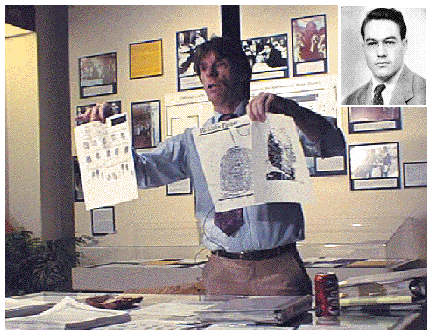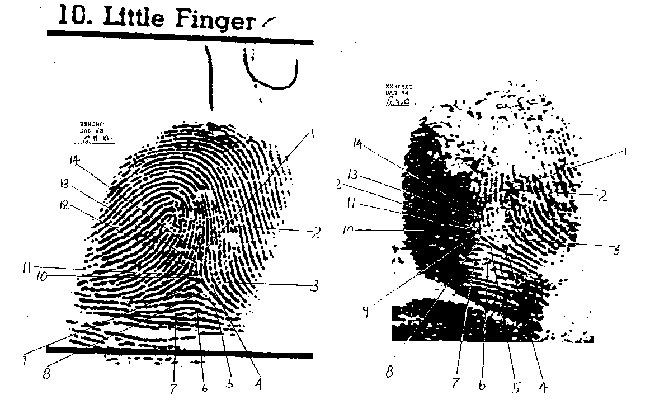
WALLACE FINGERPRINT
A.
Nathan Darby's Affidavit
The
following sworn affidavit was given by fingerprint expert A. Nathan Darby this
past spring.
Those
following recent developments in the JFK case will recall that Darby, who holds
certification by the Internal Association for Identification, concluded that
previously unidentified fingerprints taken from cartons on the sixth floor of
the Texas School Book Depository on November 22, 1963, were those of Malcolm E.
"Mac" Wallace, a convicted killer with ties to Lyndon Johnson. (See Fair
Play #23, July-August 1998.)
Darby's
identification was made "blindly" --- that is, without his knowing the
identity of Wallace, or of the implications of naming him. After making the ID
and learning all that was involved, however, Mr. Darby stuck to his conclusions.
Thanks
to Walt Brown and JFK/Deep Politics Quarterly for a copy of this affidavit.
9 March 1998
THE STATE OF
Affidavit
1.
My name is A.
Nathan Darby. I am a resident of
2.
I have been
active in law enforcement for many years, starting with the Texas Department of
public Safety as a State Trooper in 1938. I then served with the
3.
I first became
interested in fingerprint work in 1942. My direct work in fingerprint
identification began soon after, during my military service. I joined the
4.
On 1 January 1948
I was promoted to sergeant and assigned to the Identification Section of the
Austin Police Department. On 7 July 1953 I was promoted to lieutenant. In 1956,
I was made supervisor of the four employees of Identification and Criminal
Records Section of the Austin Police Department. At this time I handled the
classification of 176,000 cards and expanded the section to fourteen employees,
training and supervising all personnel. In 1970, I worked on advanced
record-keeping with the Kodak Miracode system and developed the fingerprint and
photograph coding method for the system. During this time I also served on the
board of directors of the
5.
Since 1949, I
have testified in numerous cases in the State and Federal Courts about
fingerprint identification. This testimony included the preparation of latent
charts as exhibits. There was never a mistrial or appeal based on my testimony.
Attached is Exhibit DAN#2. This exhibit shows the opinions of two District
Judges,
...
6.
Fingerprints are
an important part of law enforcement because no two prints are alike. Although
no person has been able to calculate the likelihood of a mismatch with
statistical certainty, the courts accept the admissibility of evidence from
fingerprints. Human fingerprints are from unique ridges, which are useful for
gripping and holding. An inked fingerprint is the reproduction of the ridges of
the finger. An inked fingerprint is provided by putting black ink on the finger
and then placing the finger on a suitable contrasting background surface, such
as white paper. A latent fingerprint is the production of ridges when the finger
has been placed on a surface. The ridges of the finger leave a residue, body
fluids, and chemicals on the surface touched. The latent prints are recovered
and compared to the inked prints.
For an expert to identify a latent print with an inked print,
matching formations must be found on both prints. The ridge lines between the
matched formation are then counted. This ridge count must be the same count for
both the latent and the ink print. There is no fixed documented limit on how
many matching points must be made. The identifying marks on the Ink print and
the latent print are then marked and numbered. A conclusion and identification
is then made based on the location of the characters on the prints, their
formation, and the ridge count between them.
7.
Recently I
received a photocopy of an inked print along with a photocopy of a latent print
from [
8.
In addition to
exhibit DAN#3 and exhibit DAN#4, [researcher] gave me a photocopy of a standard
form fingerprint card. This is exhibit DAN#5. Exhibit DAN#5 is from an unknown
source and has fingerprints of an unknown person to me. The space#10 on exhibit
DAN#5 is the same inked print as
DAN#3. Space #10 on exhibit DAN#5 is the space used for the left little finger.
There are other indications that the print in space #10 on Exhibit DAN#5 is the
left little finger.
9.
Based on my
comparison, I conclude that the unknown person to me who produced the inked
fingerprint Exhibit DAN#3 produced the latent print Exhibit DAN#4, and produced
the print in space #10 on exhibit DAN #5.
/s/ A. Nathan Darby
Subscribed and sworn to
before me this 12 day of March, 1998.
/s/ [not easily read]
Notary Public for
-------------------------------------------------------------------------------------------------------------------
WALLACE FINGERPRINT 1
JFK Breakthrough?
Text by John Kelin;
photograph Copyright © 1998 by Mike Blackwell
A Texas-based assassination research group has publicly named
a man believed to have left a previously unidentified fingerprint on a box
making up the so-called "sniper's nest" on the sixth floor of the
At a May 29 press conference in Dallas, researcher and author
Walt Brown said that the fingerprints belong to Malcolm E. "Mac"
Wallace, a convicted killer with ties to Lyndon Baines Johnson. The fingerprints
have been officially unidentified since President Kennedy was assassinated in
1963.

Walt Brown presenting fingerprint data; Malcom Wallace (inset)
Brown presented data showing a 14-point match between
Wallace's fingerprint card, obtained from the Texas Department of Public Safety,
and the previously unidentified print, a copy of which was kept in the National
Archives. The match was made by A. Nathan Darby, an expert with certification by
the International Association of Identifiers.
The

DPD print (left) matched by Darby to unidentified print from TSBD (right)
Malcolm Wallace, convicted in a 1951 murder and suspected in
others, has been linked to the 1961 death of
Estes alleged in 1984 that LBJ ordered the killings of
Marshall, President Kennedy, and half a dozen others, and that Wallace carried
them out. A grand jury decided that same year that Henry Marshall was murdered
as a result of a conspiracy involving then-Vice President Johnson, his aide
Wallace was killed in a single car automobile accident in
January 1971.
Barr McClellan, a Houston attorney and part of the Texas
research team, told Fair Play that he began to focus on Wallace during
his work as attorney-partner with Ed Clark, whom he described as an
In the petition filed with the ARRB, McClellan wrote:
"My direct involvement with
The Wallace fingerprint match by Darby has been disputed by
Glen Sample, who represents California-based researchers whose investigation
parallels the
In support of this, Sample offers fingerprint experts of his
own. "Both of our experts are working police I.D. officers," he wrote
on his web page. "They go to court on a regular basis, testifying as expert
witnesses. They said that the print was CLEARLY not a match. But what about the
14 points? They said that it is NOT uncommon to have a set of prints that have
many matching points, but when they find points that DO NOT match, these negate
the matching points." Sample characterized this finding by his experts as
"bad news."
Walt Brown countered by saying that Sample's experts
"were local i.d. bureau guys from San Bernadino, and not in the category of
either Nathan Darby or the people that it was hoped would examine the originals
within the law enforcement communities charged with the proper
investigation."
The
Darby is a Certified Latent Print Examiner with many years
experience. He affirmed in a notarized affidavit that he found 14 matches
between a National Archives "unknown" print, taken from what the
The findings of the
Left unanswered by the Wallace revelations are details such
as Lee Oswald's true role, the placement of other Dealey Plaza shooters, and the
identity of who financed the assassination.
There are suggestions that Wallace had ties to the world of
Intelligence. The Texas researchers are formally urging the Review Board to
highlight areas for further investigation, including disclosure of Wallace's
employment records, and records of investigations of Wallace by the Office of
Naval Intelligence and the Department of Defense.
WALLACE
FINGERPRINT 2
Mac Wallace Update
The following statement was received by Fair Play in late
March. It was sent to us by Barr McClellan, the
Briefly, that story outlined a match made by leading expert
A. Nathan Darby, between a known fingerprint of convicted murderer Malcolm E.
"Mac" Wallace, and a previously unidentified print found on a carton
on the TSBD at the time of the JFK assassination.
* * *
STATEMENT
REGARDING PRINT EVIDENCE
1.
FBI REPORTS NO PRINT MATCH: We were advised Monday that the National ID
Center of the FBI in Washington's review of independent print expert A. Nathan
Darby's fingerprint match between the left little finger of Mac Wallace and
latent print #29 on box "A" from the "sniper's nest" on the
sixth floor had concluded there was no match. We regret this decision. We know
the FBI's review process was incomplete and should not be accepted.
2.
OBTAINING THE FBI REPORT: The "no match" report was verbal and
not supported with any documentation to either the FBI's
3.
SOME OBVIOUS FBI ERRORS: The initial problems with the FBI review was
that they violated their key written standard of backing certified experts. The
FBI also violated the important related standard of reviewing any match with the
right granted to the certified expert to explain his conclusions to another
certified expert. Although repeatedly made available to the FBI, they acted
without talking to Mr. Darby.
We
will be seeking not just the report but all participants in the FBI's review
process. Why this review took almost a year is also unacceptable. The FBI was
provided the prints in May 13, 1998 and simply took its time. We know many
people had to be involved. We believe it vital to see who participated and how.
We do not expect an easy or a quick response to our freedom of information
requests along these lines; however, we are pushing forward.
4.
CHALLENGE FOR INDEPENDENT REVIEW: What is also needed in the print review
process is independent, unbiased review. We also need to make the standards
clear for the review. We are proposing a further review where the government is
not acting in judgment of itself, where the FBI is not defending its prior
actions in the assassination, and where the known complications of solving the
most terrible crime in our Nation's history can be judged properly, not by some
unattainable standard no other criminal would be judged by.
5.
UNDERSTANDING PRINT EXPERTISE: In addition to proposing an independent
review, we are also preparing a full and complete response to print
identification. Mr. Darby has taken the initiative and his report will be made
available as soon as it is finalized. Then the research community and the public
can make their own decision based on the facts. There is judgment involved in
print identification. With our report, the public will see why no two prints are
alike, even from the same person, and we will see the vital role played by
experts, particularly in a crime where there are key eyewitnesses. The FBI has
forced us to put the entire expertise of fingerprint identification on trial. We
are prepared to go forward as the FBI has forced us to do.
6.
WE HAVE A SOLID MATCH: We assure everyone following this vital issue that
we stand by our expert and his careful, independent, and unbiased
identification. We fully support his honest and his sound judgment.
We will keep you advised of further developments.
Contact Information tomnln@cox.net
Page Visited
Times

